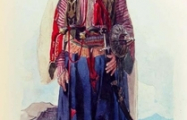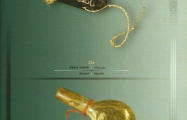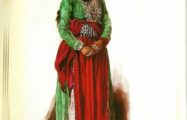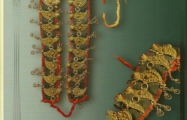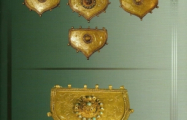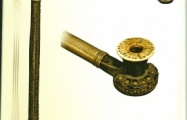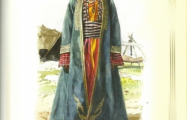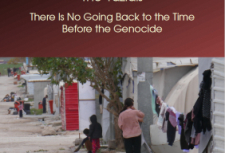Antiquity and uniqueness of the Yazidi people and samples of Yazidi culture from the state Museum of Georgia
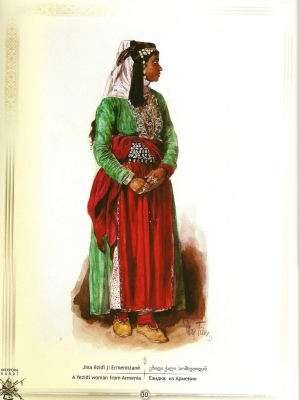
Yazidis are among the oldest peoples of the world. They are native inhabitants of the Middle East and have historically inhabited mountainous areas from Northern Mesopotamia to the Southern Caucasus.
Yazidis language – ancient. Historically ‘there was a Yazidi alphabet, which were filled with the Scriptures of the Yazidis. Throughout their centuries-old existence, the Yazidis took an active part in the political life of the Western Asia and wrote many significant pages in its dramatic history.
At the same time, it is necessary to take into account both Yazidis who adhere to their faith, and Yazidis who have moved away from the traditional Yazid religion, many historians combine the common term "Kurds". Therefore, when we read from such historians about the "Kurdish children" we must understand that we are talking primarily about the Yazidis. Although it should be recognized that the situation actually Yazidis worsened after part of the people gradually converted to Islam. These circumstances exacerbated the religious and ethnic aspect, which on religious grounds resulted in a de facto confrontation between the Muslim Kurds and supporters of Yazidis.
Nevertheless, initially Yazidi roots of a number of outstanding historical figures are undeniable. Such, according to scientists, had the Sultan of Egypt and Syria Salah al-DIN (Saladin) (CHI V.) founder of the dynasty of Ayubids. Also, representatives of the feudal dynasty of the Sheddadids were originally of Yazidi origin. The founder of this dynasty was the noble Muhammad Ibn Shedded, whose family remained in power from 951 to 1199. Sheddadids ruled the most important centers of the South Caucasus - the regions of Dvina and Ganji.
It is important to say about the activities of the famous Yazidis who moved to Orthodox Christianity - representatives of the genus Mkhargrdzeli. Brothers Ivan and Zakaria Mkhargrdzeli at the court of Georgian kings held high public positions. In the 12-13 centuries under the auspices of Georgia they ruled a significant part of the present territory of the Republic of Armenia.
In the second half of the 19th century, a certain part of the Yazidis was under Russian rule. Yezidis settled in the South Caucasus were mainly engaged in their traditional business - cattle breeding. Yazidis mainly lived in Surmala, Echmiadzin and Alexandropol Counties of Erivan province. In Georgia, with which the Yazidis have been associated for many centuries (suffice it to recall the above-mentioned brothers Mkhargrdzeli), the bulk of the Yazidis moved in 1918, from the Ottoman Empire
The ethnic culture of the Yazidis people is diverse, which was caused by long contacts with different ethnic communities. The originality of this culture could not remain unnoticed for the leadership of the Caucasian Museum, founded in 1852, which at the initial stage of its work set out to collect objects of material culture of the peoples of the Caucasus. It was a process that lasted a century, which ended with significant results, which was expressed in the collection of unique materials, among which its rightful place is occupied by Yazidi exhibits. The collections of this Museum became the basis of the collections of the State Museum of Georgia.
In 1900 the Caucasus Museum were invited by the famous German artist, Explorer costumes Max Tilke, who drew portraits of people in national costumes, including Yazidis and Muslim Kurds. He presented the Yazidis and Muslim Kurds as the upper classes, and representatives of ordinary people whose clothing stands out with its brilliance. These collections are reflected in the perfectly executed works of the artist - a total of twelve drawings, of which nine portrait genre.
One of the drawings attracts a lot of attention, which in this catalog is placed under the number 10. This picture shows a typical Yazid in a rich national costume. It is the anthropological type of the beautiful figure among the colourful mosaic of ethnic groups. Caucasus, the nature of which the visible pride and courage. The wide-belted dagger gives it a self-assured look. Decorated with a curly ornament, his elegant robe stands out for its artistic brilliance.
Of the peoples inhabiting the middle East, Yazidis are rebellious and belligerent spirit. Obviously, this prompted the Armenian humanist writer Khachatur Abovyan to call them “knights of the East“. Despite the fact that part of the Yazidis led a nomadic lifestyle, the art of production of military weapons was developed among the Yazidis and its wearing was mandatory not only during the war, but also in peacetime. The weapon was an integral part of the Yazidi national costume, and it had not only combat, but aesthetic purpose.
The weapons Fund of the ethnographic Department of the State Museum of Georgia stores samples of Kurdish and Yazidi military art, which are presented in this catalog by regions of compact residence of Yazidis and Muslim Kurds.
The samples of Yazidi applied art include women's jewellery and amulets stored in the Fund of Oriental products, which were purchased by the Museum in the late twentieth and early twentieth centuries. These objects are expressed as samples of Kurdish jewellery art, and motifs characteristic of syncretic beliefs.
The middle East was once the cultural cradle of humanity. Here, among the nomadic peoples engaged in cattle breeding, the basis for the production of carpets was also laid. These include Yazidis, who created the original samples of carpets. At the moment, most of the carpets stored in the State Museum of Georgia are mainly woven by Yazidis from the present territory of the Republic of Armenia.
Yazidi and Kurdish carpets are characterized by an oblong shape, which is dictated by the specifics of their housing - a tent of nomads. Of these, the most famous carpets — type "give", which consist of several parts. They are mainly used to lay on the floor of the tent. In the Fund of Museum there are samples of traditional Azerbaijani carpets (kilim, Amani): pastilok, curtains, carpets (jajim, shadda, Vern, Sumy), which are in the form of carpets without pile. They are woven in the style of kilim, on a vertical Board so-called window image, which gives them a special effect.
Yazidis who have adopted a sedentary farming together with large postelemi - tracks, Cali small carpets (Mir) for the walls.
A certain part of the Yazidis of Georgia who migrated from Turkey led a semi-nomadic lifestyle. Their main dwelling was a traditional tent. The tent and its details stored in the Museum of Georgia belonged to this part of Yazidis. Especially remarkable is the upper part - the dome of the tent, which is decorated with different collared fabrics in the way of application. The tent also consists of wooden props, insulated felt, etc. In the face of this tent we are dealing with one of the best examples of the dwelling of the Yazidi people.
Translated by David Babaev
Yazidis.info
Tags:
Antiquity and uniqueness of the Yazidi people and samples of Yazidi culture from the state Museum of Georgia

Yazidis are among the oldest peoples of the world. They are native inhabitants of the Middle East and have historically inhabited mountainous areas from Northern Mesopotamia to the Southern Caucasus.
Yazidis language – ancient. Historically ‘there was a Yazidi alphabet, which were filled with the Scriptures of the Yazidis. Throughout their centuries-old existence, the Yazidis took an active part in the political life of the Western Asia and wrote many significant pages in its dramatic history.
At the same time, it is necessary to take into account both Yazidis who adhere to their faith, and Yazidis who have moved away from the traditional Yazid religion, many historians combine the common term "Kurds". Therefore, when we read from such historians about the "Kurdish children" we must understand that we are talking primarily about the Yazidis. Although it should be recognized that the situation actually Yazidis worsened after part of the people gradually converted to Islam. These circumstances exacerbated the religious and ethnic aspect, which on religious grounds resulted in a de facto confrontation between the Muslim Kurds and supporters of Yazidis.
Nevertheless, initially Yazidi roots of a number of outstanding historical figures are undeniable. Such, according to scientists, had the Sultan of Egypt and Syria Salah al-DIN (Saladin) (CHI V.) founder of the dynasty of Ayubids. Also, representatives of the feudal dynasty of the Sheddadids were originally of Yazidi origin. The founder of this dynasty was the noble Muhammad Ibn Shedded, whose family remained in power from 951 to 1199. Sheddadids ruled the most important centers of the South Caucasus - the regions of Dvina and Ganji.
It is important to say about the activities of the famous Yazidis who moved to Orthodox Christianity - representatives of the genus Mkhargrdzeli. Brothers Ivan and Zakaria Mkhargrdzeli at the court of Georgian kings held high public positions. In the 12-13 centuries under the auspices of Georgia they ruled a significant part of the present territory of the Republic of Armenia.
In the second half of the 19th century, a certain part of the Yazidis was under Russian rule. Yezidis settled in the South Caucasus were mainly engaged in their traditional business - cattle breeding. Yazidis mainly lived in Surmala, Echmiadzin and Alexandropol Counties of Erivan province. In Georgia, with which the Yazidis have been associated for many centuries (suffice it to recall the above-mentioned brothers Mkhargrdzeli), the bulk of the Yazidis moved in 1918, from the Ottoman Empire
The ethnic culture of the Yazidis people is diverse, which was caused by long contacts with different ethnic communities. The originality of this culture could not remain unnoticed for the leadership of the Caucasian Museum, founded in 1852, which at the initial stage of its work set out to collect objects of material culture of the peoples of the Caucasus. It was a process that lasted a century, which ended with significant results, which was expressed in the collection of unique materials, among which its rightful place is occupied by Yazidi exhibits. The collections of this Museum became the basis of the collections of the State Museum of Georgia.
In 1900 the Caucasus Museum were invited by the famous German artist, Explorer costumes Max Tilke, who drew portraits of people in national costumes, including Yazidis and Muslim Kurds. He presented the Yazidis and Muslim Kurds as the upper classes, and representatives of ordinary people whose clothing stands out with its brilliance. These collections are reflected in the perfectly executed works of the artist - a total of twelve drawings, of which nine portrait genre.
One of the drawings attracts a lot of attention, which in this catalog is placed under the number 10. This picture shows a typical Yazid in a rich national costume. It is the anthropological type of the beautiful figure among the colourful mosaic of ethnic groups. Caucasus, the nature of which the visible pride and courage. The wide-belted dagger gives it a self-assured look. Decorated with a curly ornament, his elegant robe stands out for its artistic brilliance.
Of the peoples inhabiting the middle East, Yazidis are rebellious and belligerent spirit. Obviously, this prompted the Armenian humanist writer Khachatur Abovyan to call them “knights of the East“. Despite the fact that part of the Yazidis led a nomadic lifestyle, the art of production of military weapons was developed among the Yazidis and its wearing was mandatory not only during the war, but also in peacetime. The weapon was an integral part of the Yazidi national costume, and it had not only combat, but aesthetic purpose.
The weapons Fund of the ethnographic Department of the State Museum of Georgia stores samples of Kurdish and Yazidi military art, which are presented in this catalog by regions of compact residence of Yazidis and Muslim Kurds.
The samples of Yazidi applied art include women's jewellery and amulets stored in the Fund of Oriental products, which were purchased by the Museum in the late twentieth and early twentieth centuries. These objects are expressed as samples of Kurdish jewellery art, and motifs characteristic of syncretic beliefs.
The middle East was once the cultural cradle of humanity. Here, among the nomadic peoples engaged in cattle breeding, the basis for the production of carpets was also laid. These include Yazidis, who created the original samples of carpets. At the moment, most of the carpets stored in the State Museum of Georgia are mainly woven by Yazidis from the present territory of the Republic of Armenia.
Yazidi and Kurdish carpets are characterized by an oblong shape, which is dictated by the specifics of their housing - a tent of nomads. Of these, the most famous carpets — type "give", which consist of several parts. They are mainly used to lay on the floor of the tent. In the Fund of Museum there are samples of traditional Azerbaijani carpets (kilim, Amani): pastilok, curtains, carpets (jajim, shadda, Vern, Sumy), which are in the form of carpets without pile. They are woven in the style of kilim, on a vertical Board so-called window image, which gives them a special effect.
Yazidis who have adopted a sedentary farming together with large postelemi - tracks, Cali small carpets (Mir) for the walls.
A certain part of the Yazidis of Georgia who migrated from Turkey led a semi-nomadic lifestyle. Their main dwelling was a traditional tent. The tent and its details stored in the Museum of Georgia belonged to this part of Yazidis. Especially remarkable is the upper part - the dome of the tent, which is decorated with different collared fabrics in the way of application. The tent also consists of wooden props, insulated felt, etc. In the face of this tent we are dealing with one of the best examples of the dwelling of the Yazidi people.
Translated by David Babaev
Yazidis.info
Tags:
